If you want to experience a WW2 handgun without paying antique prices, the Walther P1 is a direct descendant of the iconic Nazi P38 and a lot cheaper to own. The Walther P1 is the aluminum-framed copy of the WWII Walther P38 pistol and has its own history. For 25 years these pistols served with the Bundeswehr and West German police. During the 1990s the Germans began phasing out the P1, fielding the P8 (a military version of the H&K USP), finally retiring the weapon altogether in 2004. The P1 is now readily available on the civilian market.
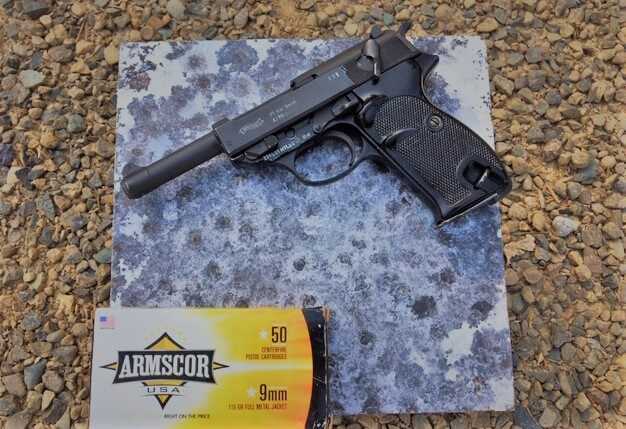
Everyone who has seen a WW2 movie thinks the Nazis all carried a Luger P08. While some of them did, their main sidearm was the P38. Lugers fought in the Great War and were the standard-issue sidearm for the German military from their adoption in 1909 until 1938. They were an innovative design in their day and brought us the standard 9×19 round (also called 9mm Luger).

Handguns are support weapons and in a wartime economy, cheap and effective beats pretty every time. Experience in the Great War had shown the Lugar to be complicated and expensive to manufacture. The toggle operating system did not tolerate hostile conditions well so Walther developed a more reliable and less expensive option, the Pistole 38 or P38.
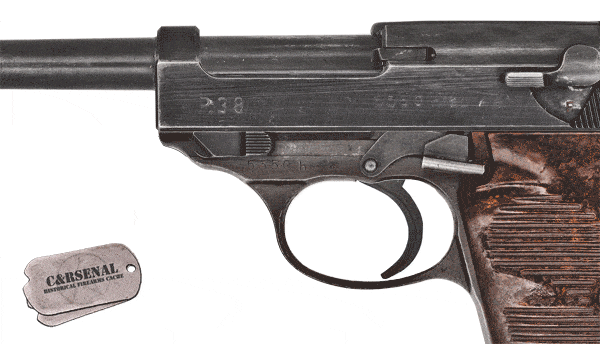
The P38 is a full-size service pistol chambered with the standard 9x19mm Parabellum cartridge firing from an 8-round magazine. One of the first double-action handguns, it allowed Soldiers to safely carry the P38 with a round chambered and the hammer down, needing only to draw and squeeze the long double-action trigger pull to fire (without manipulating a manual safety).
Military production began in 1939 with Walther. The demand for the P38 was so high, that Mauser and Spreewerk also received contracts producing over one million P38s during the war. P38s went on to see combat in every theater of war and field use in harsh conditions proved it to be a magnificent design. The only reason the Germans issued so many other handguns was that there were never enough P38s available.
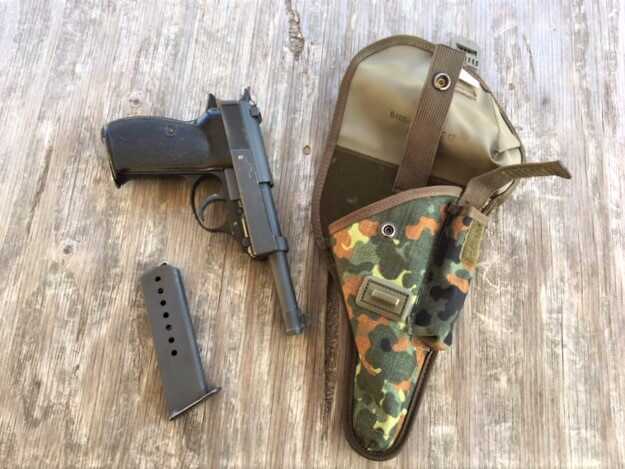
As WW2 ended, the Cold War began and the P38 received a new lease on life. The new German army (Bundeswehr) wanted the gun they knew, Walther updated the design, replacing the steel frame with a lightweight aluminum alloy unit (during the war, aluminum was prioritized to the Luftwaffe for aircraft). In 1955, the initial production run of new pistols was marked “P38”, The design was de-Nazified and adopted in 1957 as the Pistole 1. This model served not only the various branches of the Bundeswehr but also the Austrian Army, for decades.
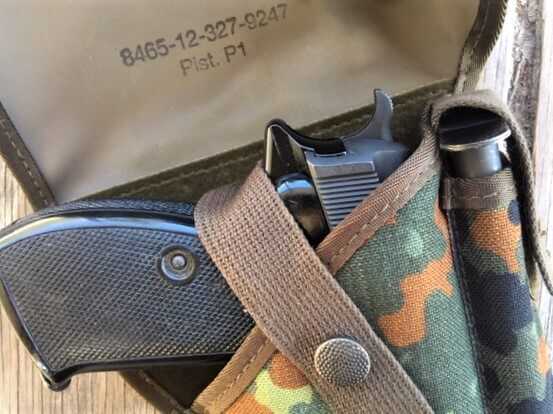
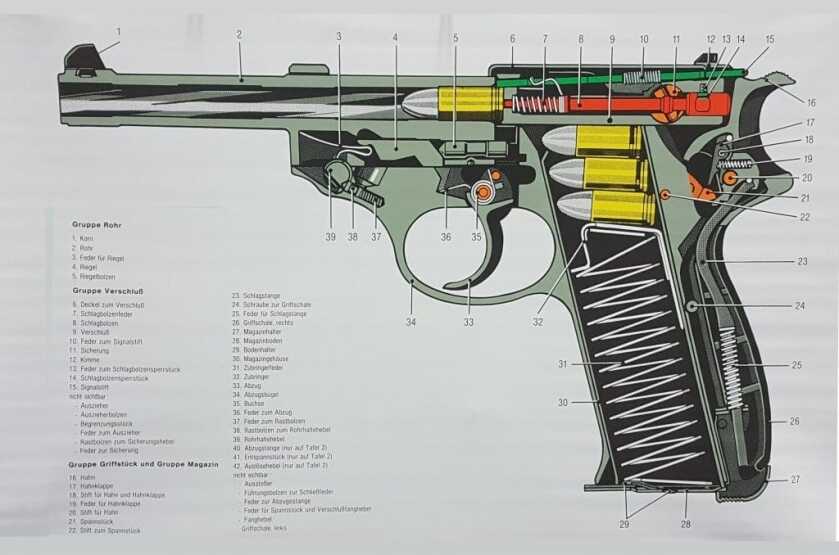
The original Walther factory was in the Soviet occupation zone. What was not stolen was destroyed by the Russians. The Manurhin company in France made the P1 gun for several years under contract until Walther built a new factory in Ulm/Donau. Walther built the P1 for the West German military and police for more than 25 years. They are marked ‘P-1’ and have a four-digit production date on their frame. The date is simple to figure out, my gun is marked 04/79, it was made in April of 1979.
P1 and the P38
The P1 is different than the P38. The design is almost exactly the same, but it isn’t the same gun. The P1 frame is aluminum, the P38 is steel-framed. For all intents and purposes, both guns feel and shoot the same. In 1975, the aluminum frame was reinforced with a hex bolt above the trigger guard, and a thicker, stronger slide was added.
I was cruising my local gun store and saw a camo holster, a German flecktarn holster. Then I saw the gun. A very good condition P1 with all the family charm of its WW2 relatives. For less than a used Glock, I got to find out why the Germans kept this gun for so many years. I was not disappointed and I learned a great deal about where modern handgun features originated. (Spoiler Alert: Everybody but Browning stole something from this gun. Looking at you Beretta, SIG and Glock.)
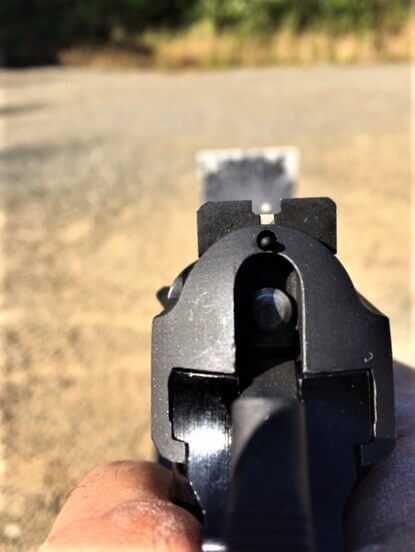
The P1 and the P38 are true double-action / single-action guns. It was designed to be carried with the chamber loaded and the hammer de-cocked using the lever. With the safety off, a double-action pull of the trigger will cock and then fire the gun.

Walther P1 Specifications
- Method of Operation: Short recoil
- Caliber: 9x19mm Parabellum
- Action: Double Action / Single Action
- Safety: Decocker, Manual Safety, Firing Pin Block Drop Safety
- Trigger Pull: Single Action 5.5 lbs / Double Action 9.5 lbs
- Sights: Fixed Front Post with White Dot and U-Notch Rear
- Overall Length: 8.5″
- Overall Width: 1.5″
- Weight: 27 ounces
- Barrel: 4.9 inches, 6 groove 1-10 Right Hand twist
- Feed: 8-round single-stack detachable magazine
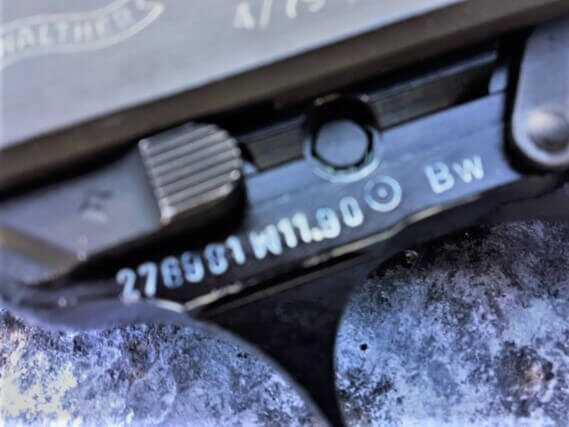
The P1 has a manual safety / de-cocking lever, a last round slide lock mechanism, and a take-down lever, all on the left side of the pistol. The slide locks back after the last round was fired, a tab in the magazine pushes up on the slide lock. The only feature not familiar to modern shooters is the magazine release on the bottom rear of the magazine well.
This release is a common feature on older European handguns. In Europe, magazines are scarce and human life is cheap. Nobody cared about rapid reloads. You got two magazines with your handgun and they were serialized. You were forced to retain the magazine by design.
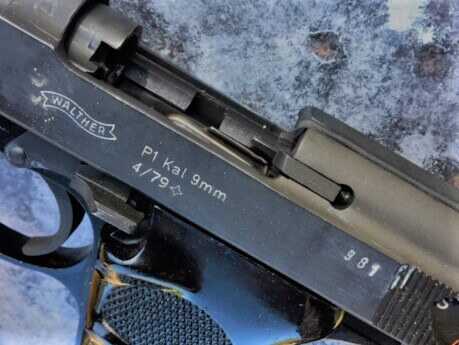
There’s a prominent loaded-chamber indicator just above the hammer which protrudes to indicate the pistol’s condition. A glance or touch will reveal the weapon’s status. This little part could easily get hung up on something and is a bit of complication which could have been avoided.
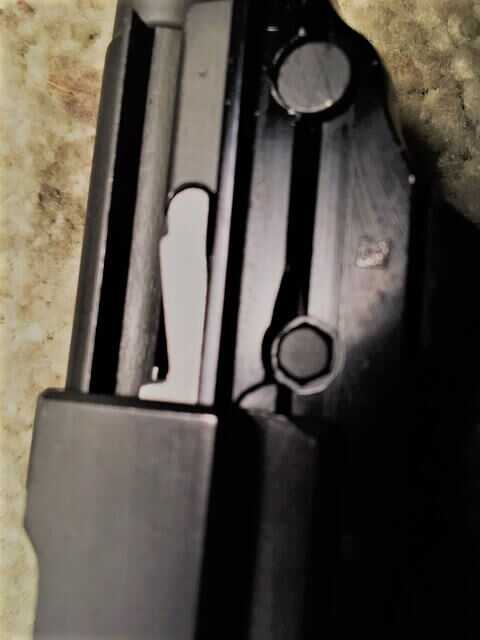
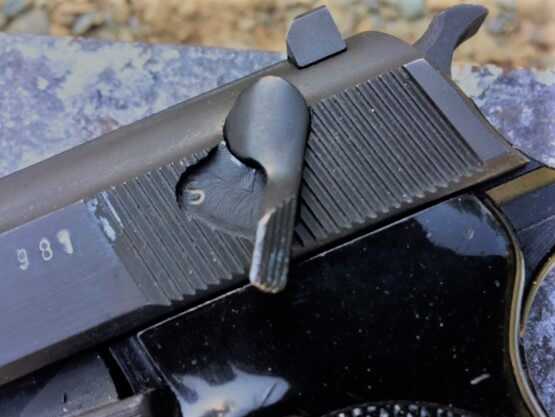
Though based on a WW2 design, the P1 is a contemporary of the SIG P226 and the Beretta 92 (M-9). While the single stack 8-round magazine can’t compete with the double stack super nines, I find the ergonomics superior to the M-9 I was issued. The P1 sights and trigger are better and I can shoot it faster and better than the M-9.
The Beretta grip is fat and the trigger pull is long and heavy. The ambidextrous safety/de-cocker on the M-9 is very easy to activate when manipulating the slide. This provides a surprise dead gun after a re-load or malfunction. It is always a bad surprise. The P1 weighs in at 27 ounces, (unloaded) versus 33.9 for the M-9. The only advantages of the M-9 are the magazine release and a 15 round magazine.
Shooting
The P1 feels good. The thumb rest and lanyard ring on the left grip are designed for righties. The slide stop and decocker/safety are positioned for right-handed manipulation. How did the Germans accommodate left-handers? They forbid left-handed shooting. Problem solved.
This is not a show stopper for the lefties. There are no left-handed holsters, but the controls can be manipulated left-handed or with the support hand. The magazine release is ambidextrous.
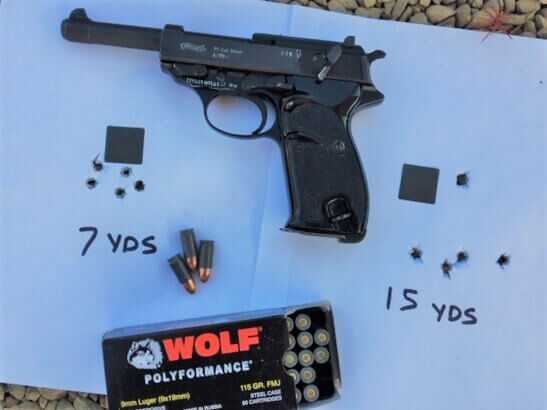
The P1 is made for a flap holster and has a prominent front sight, sharp edges on the slide, and an awkward loaded chamber indicator. The is not your new EDC or concealed carry gun. In spite of a single stack mag, the slide and grips are 1 1/4″ thick. The de-cocker and slide release also stick out with sharp angles that can snag.
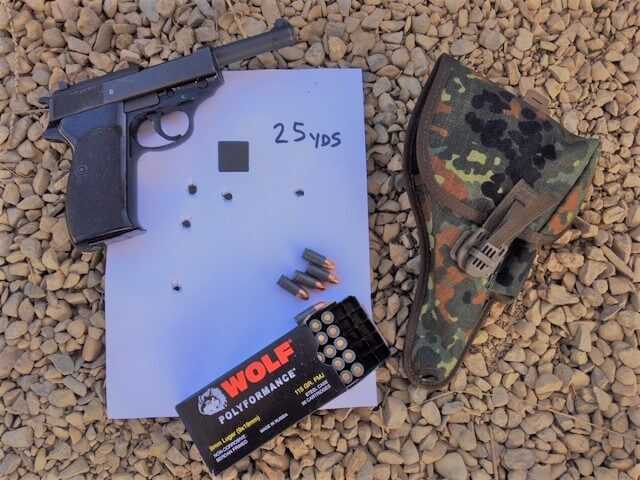
Using my Bundeswehr surplus flectarn camouflage pattern flap holster I took my P1 to the range over a couple of months. The operation is just like the SIG and Beretta except for the magazine release. The de-cocker must be manipulated before holstering. Reloads are just the same as more modern guns.
The 8+1 capacity was a limitation but not that big a deal. Trying to draw from the flap and reload from the holster was slow, but they were designed to protect, not to gunfight. It was expected that your gun would be in your hand if you needed it.
I used several different loads, ranging in bullet weight from 115 to 147 grains, including the dreaded +P loads. I have heard that you shouldn’t use +P in an aluminum frame. The P1 was designed to shoot hot NATO spec submachinegun ammo. It will handle +P, but you should expect accelerated wear. The P1 fed everything I tried with grace and a complete lack of malfunctions. The dual recoil springs are old but they have plenty of flex left in them.
The only thing odd about shooting the P1 is the magazine well magazine release. That said, It was not that hard to hit the release and pull the magazine out. It is a little slower, but works just fine with a little practice. In Europe, life is cheap and magazines are scarce. The magazines were seen as components of the weapon to be kept for life.
The dot front and strip rear sights are as good as any service pistol sights I have ever seen. The double-action pull is as good as a SIG and better than Beretta. The single-action pull and reset are better than a Glock. Felt recoil is very manageable with little flip. The weight is all in the back of the gun. Brass ejects in various directions occasionally hitting you in the head, but it always ejects.
I found the P1 shot very well for speed and accuracy from 7 yards to 50 yards. I am sure it would go farther but my range discourages shooting across the parking lot. I was unexpectedly impressed by the trigger. Light and smooth with a short re-set.
Fun Fact: the Walther P1 (imported by P.W. Arms) is on California’s roster of state-approved handguns.
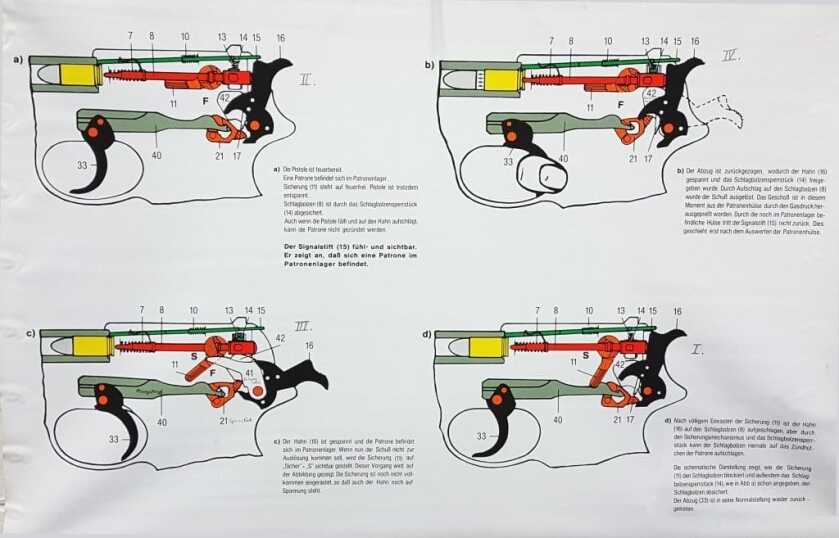

After a few hundred rounds, I found that I really liked the P1. In an open carry environment, I would pick it over the Beretta every time. I see the P1 in gun stores all the time and they are readily available online. The price of P38s has risen dramatically as collectors seek them out, with prices running around a thousand dollars. The P1 is a product improved P38 for less than half the price. Since they were manufactured as late as1980s and were not taken as war trophies after years of combat use, most P1s are in great condition.
The P1 is a fun and affordable piece of history. If you have ever thought about owning one, now is the time. In a few years, they will be collectible and un-affordable. Your kids and grandkids will thank you.


cool fire arm gun.
Hey Walther! How about bring back the P38!
What’s the price.
Cost
Judging from the comments, the more alarming characteristic of the P1/P38 design is the mental impairment that ownership can cause, particularly the need to randomly capitalize words in your response. Even merely reading the article about this pistol has a noticeable impact on reading comprehension among GunsAmerica users. This probably warrants future study, specifically on the outcome of hostilities in WW2 and the pistol selection by the Bundeswehr in post war West Germany.
I am interested in purchasing a Walter P1 or P38
Nice review of an iconic piece of history! As a fan of WWII weapons and equipment, it is nice to see it get some “screen time” since it served such a prominent role in history, rather than the Luger.
I wanted to know the price on the Walther P38 and where to buy it.
I have two P38’s, one is a AC43 with a hard shell holster with P38 in large letters on the inside of the back panel, and the other is a BYF I got with two German Police WW2 holsters and both have Wa359 and Wa135 markings respectively. Both are good shooters and are a part of my collection of WWII weapons,P08,PP,C-96,and a S.A.C.M.odd ball all with markings excepting the C-96. I got these many years ago as all who I knew back then are gone now, and as my email will show, I’m trying to save history as much as I can!! Joe L.
How can I obtain information on purchasing this item?
Check GunsAmerica and your local gun store. They turn up all the time.
How much is this Walther 9 MM pistol???
Please send all pertinent information.
Cheer’s,
Mel Whitford☀️☀️☀️🌵🇺🇸🇺🇸🇺🇸🇺🇸
I am not interested in selling my Walther but if you check GunsAmerica, one is sure to pop up eventually. They are pretty common in the used market. I found mine at my local gun store.
I own a COMMERCIAL P38 (MARKED P38 BUT NO DATE) that I bought mail order in April 1968 for $89.95. It has a gloss black aluminum frame, gloss black plastic grips and a Parkerized slide and barrel. There is NO REINFORCING BOLT.
In August 2008 I Found a P1 (MARKED P1 AND 7/79) in a gun store and bought it for $200. It Has a gloss black aluminum frame, gloss black slide and barrel, gloss black plastic stocks AND it came with A PAIR OF WOOD STOCKS!!! It has better sights than the P-38. There IS a REINFORCING BOLT. I shot the P1 in a PPC match and scored 408 out of 600 possible DESPITE the fact that the trigger pull is REALLY BAD compared to a revolver set up for shooting PPC!
Neither gun has trigger pulls NEARLY AS GOOD as my Wilson Combat Beretta 92 G Brigadier!!!
I have only used FMJ ammo except for the P38 that WILL NOT FEED Winchester Silver Tip HPs!
Great article, loved the history with and about the gun